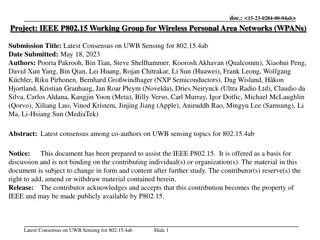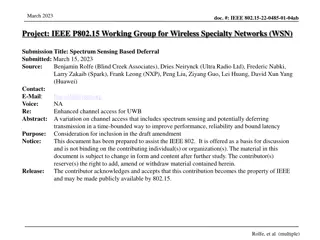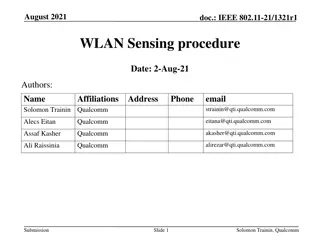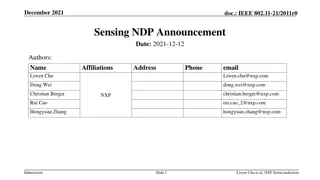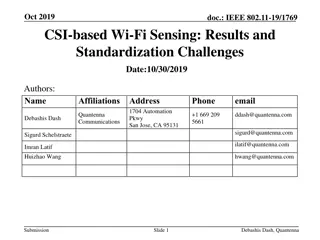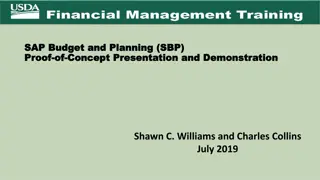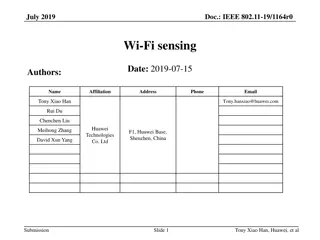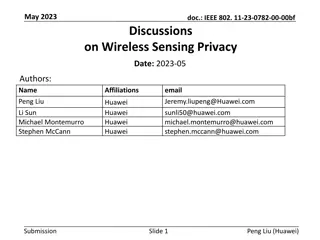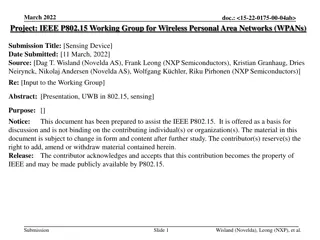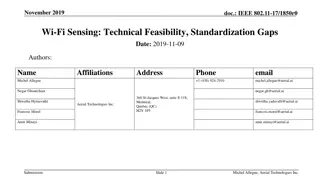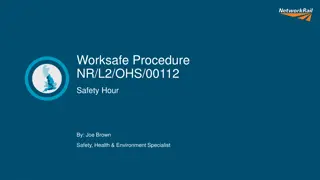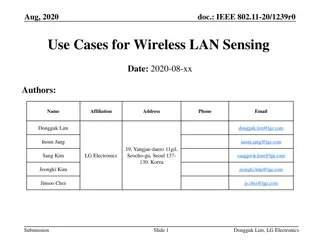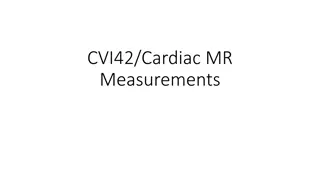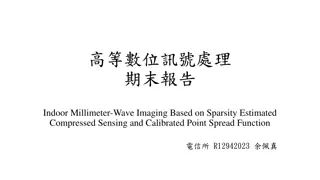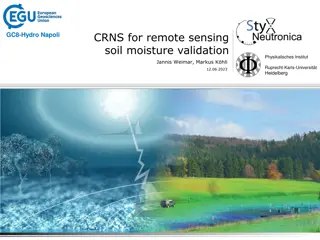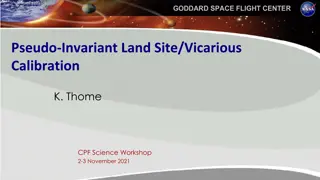Sensing Measurements in SBP Procedure
This document addresses issues related to the Sensing by Proxy (SBP) procedure reporting within the context of IEEE 802.11-22/0377r2. It delves into concerns such as the frequency of sensing measurement reports, determining reporting responsibilities, utilization of time stamps for CSI estimates, and the use of threshold-based reporting. Additionally, it discusses the selection of non-AP STAs for consistent CSI measurements over time in SBP procedures.
Download Presentation

Please find below an Image/Link to download the presentation.
The content on the website is provided AS IS for your information and personal use only. It may not be sold, licensed, or shared on other websites without obtaining consent from the author.If you encounter any issues during the download, it is possible that the publisher has removed the file from their server.
You are allowed to download the files provided on this website for personal or commercial use, subject to the condition that they are used lawfully. All files are the property of their respective owners.
The content on the website is provided AS IS for your information and personal use only. It may not be sold, licensed, or shared on other websites without obtaining consent from the author.
E N D
Presentation Transcript
February 2022 doc.: IEEE 802.11-22/0377r2 On Sensing by Proxy Date: 2022-03-03 Authors: Name Affiliations Address Phone email Dong Wei NXP dong.wei@nxp.com Submission Slide 1 Dong Wei, NXP Semiconductors
February 2022 doc.: IEEE 802.11-22/0377r2 Motivation There is little content in the subclause for SBP procedure reporting. SBP procedure reporting is not identical to the reporting phase of TB sensing measurement instance. In an SBP procedure, the SBP responder initiates and coordinates sensing measurements. This contribution discusses two issues of SBP procedure reporting which have not been addressed by TGbf. Revision 2: revised straw polls. Submission Slide 2 Dong Wei, NXP Semiconductors
February 2022 doc.: IEEE 802.11-22/0377r2 Issue 1: Frequency of Sensing Measurements After an SBP procedure is established, the SBP responder needs to report a time series of CSI to the SBP initiator. In addition, the SBP responder needs to decide when to start each sensing measurement instance. Question 1: How frequently should the sensing measurement results be reported to the SBP initiator? Question 2: Who determines the frequency of sensing measurement reports? Option 1: the SBP initiator Option 2: the SBP responder Option 3: negotiated Question 3: If the time instants of transmission of sensing NDP are aperiodic, should time stamps for CSI estimates be used in the reports? Question 4: Should threshold-based reporting be used (i.e., only if the variation between consecutive CSI estimates is significant, then the current measurement results are reported to the SBP initiator)? Simpler than the threshold-based reporting for TB sensing measurement instance Submission Slide 3 Dong Wei, NXP Semiconductors
February 2022 doc.: IEEE 802.11-22/0377r2 Issue 2: Consistent CSI Measurements over Time (I) Question: Which non-AP STAs are selected by the AP to participate in sensing measurement for the SBP procedure? Assume that two non-AP STAs participate in each sensing measurement instance. Option 1: In each sensing measurement instance, the AP chooses two STAs from whoever responds to polling, which may lead to the following scenario: In sensing measurement instance #1, STA1 and STA2 are chosen. Thus CSI of STA1-AP and STA2-AP are estimated and reported. In sensing measurement instance #2, STA3 and STA4 are chosen. Thus CSI of STA3-AP and STA4-AP are estimated and reported. In sensing measurement instance #3, STA5 and STA6 are chosen. Thus CSI of STA5-AP and STA6-AP are estimated and reported. This time series of CSI estimate is not consistent. Submission Slide 4 Dong Wei, NXP Semiconductors
February 2022 doc.: IEEE 802.11-22/0377r2 Issue 2: Consistent CSI Measurements over Time (II) Option 2: In the 1st sensing measurement instance, the AP chooses two STAs from whoever responds to polling. In the subsequent sensing measurement instances, the AP attempts to poll the same two STAs as in the 1st sensing measurement instance. However, there is no guarantee for those two STAs to be available at any of the subsequent sensing measurement instances, which may lead to the following scenario: In sensing measurement instance #1, STA1 and STA2 are chosen. Thus CSI of STA1-AP and STA2-AP are estimated and reported. In sensing measurement instance #2, neither STA1 nor STA2 responds to polling. Thus no CSI is estimated and reported. In sensing measurement instance #3, neither STA1 nor STA2 responds to polling. Thus no CSI is estimated and reported. This time series of CSI estimate does not get the job done. Remark: Consistency is less a problem for TB sensing measurement (e.g. an AP may trigger a larger number of STAs in each TF sounding phase to reduce the probability of no common STA in any two consecutive CSI measurements). Submission Slide 5 Dong Wei, NXP Semiconductors
February 2022 doc.: IEEE 802.11-22/0377r2 Issue 2: Consistent CSI Measurements over Time (III) An ideal scenario of consistent CSI measurements:the same set of STAs participate in each sensing measurement instance during the SBP procedure. In sensing measurement instance #1, CSI of STA1-AP and STA2-AP are estimated and reported. In sensing measurement instance #2, CSI of STA1-AP and STA2-AP are estimated and reported. In sensing measurement instance #n, CSI of STA1-AP and STA2-AP are estimated and reported. Question: Should a requirement be defined for the consistency of CSI measurements over time? Submission Slide 6 Dong Wei, NXP Semiconductors
February 2022 doc.: IEEE 802.11-22/0377r2 Straw Poll #1 Do you agree to add the following to the 11bf SFD? In an SBP procedure, the sensing measurement reports received by the SBP initiator shall contain the CSI from the same set of TX/RX antenna pairs. Submission Slide 7 Dong Wei, NXP Semiconductors
February 2022 doc.: IEEE 802.11-22/0377r2 Straw Poll #2 Do you agree to add the following to the 11bf SFD? For the same sensing measurement setup, the sensing measurement reports shall contain the CSI from the same set of TX/RX antenna pairs. Submission Slide 8 Dong Wei, NXP Semiconductors










